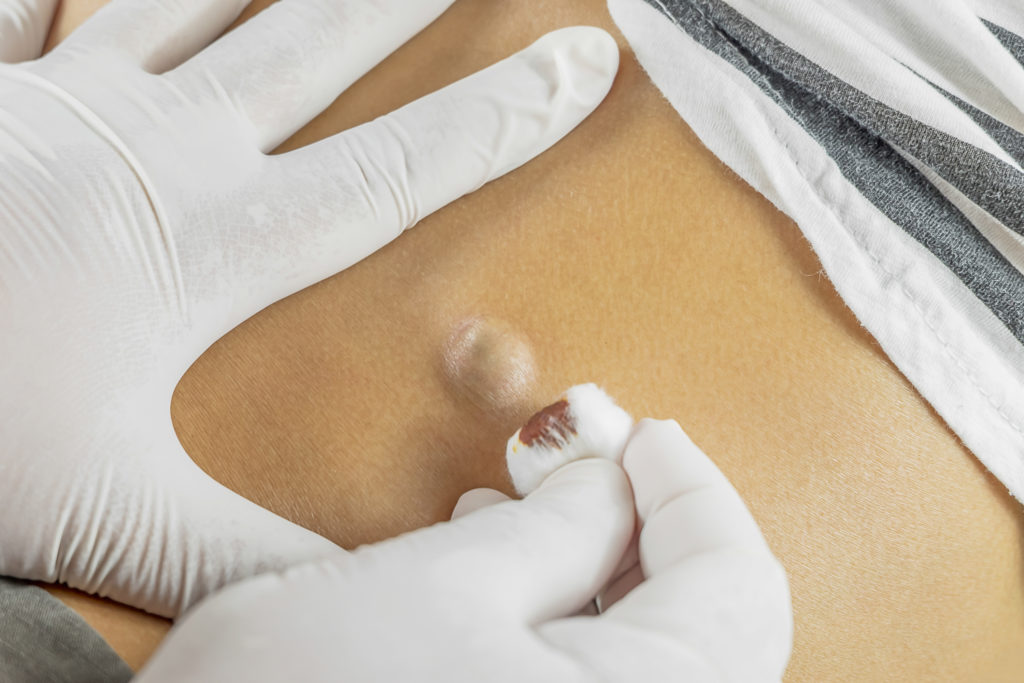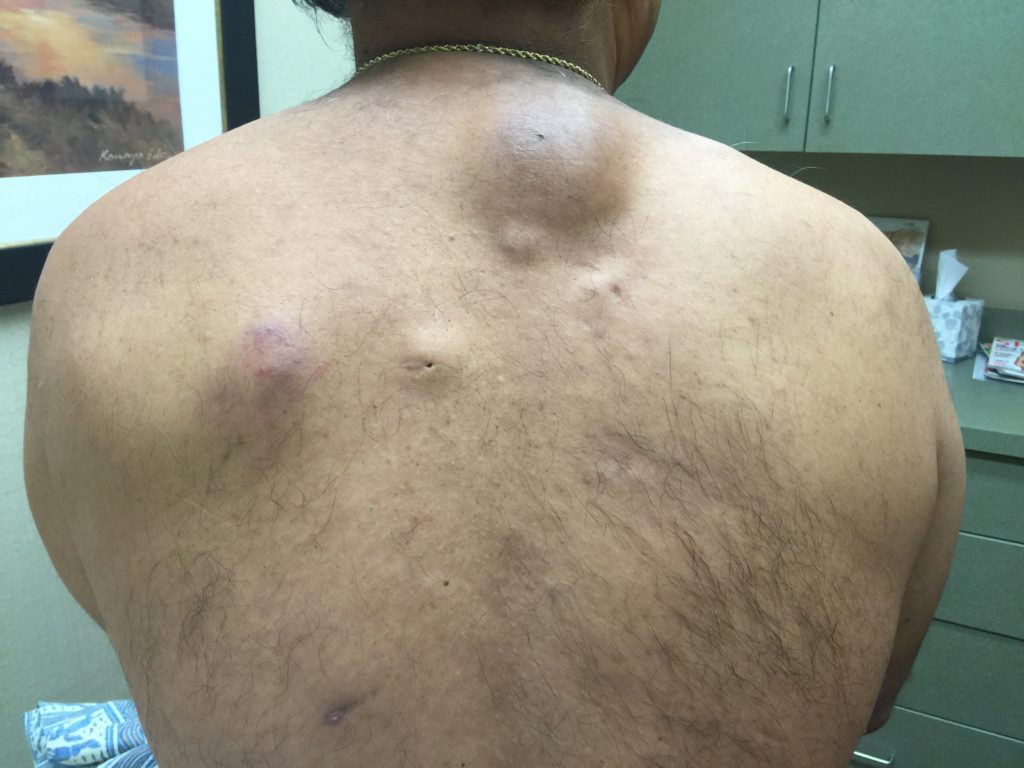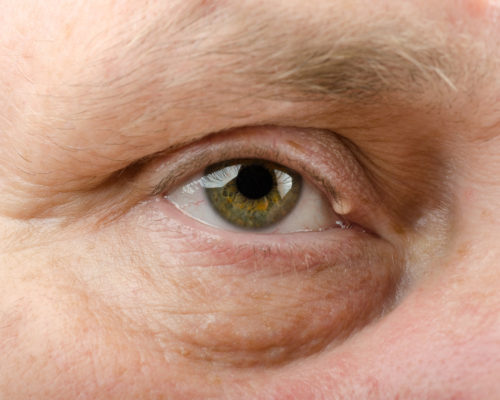We’ve all been there — you notice a lump somewhere on your face or body and proceed to freak out… majorly. What the heck is that thing?! We’ve all been down that dangerous Google/WebMD rabbit hole, but before you can enter panic mode, let’s talk about the C word: Cysts.
These bumps can form just about anywhere on your bod (and even inside of it), but luckily most of them are pretty harmless and will go away on their own. Phew. We’ve got the goods on the most common types of cysts and how to treat them.

Cysts: What Are They, Really?
It’s important to understand that pretty much every organ in the body can grow cysts, from follicular cysts on the ovaries to cysts on the kidneys, vocal cords, or breasts. They can even grow on the tongue or behind the eyes. In this article, we’re only talking about cysts in the skin.
Simply put, cysts in the skin are balloon-like bumps under the skin’s surface that can be filled with any state of matter — meaning liquid, solid, or gas. Skin cysts can rear their ugly heads just about anywhere on your body (your face, neck, or torso, for example). Typically, cysts form beneath the surface of your skin in the shape of a round lump.
Cysts can also vary in size — they can be as small as a pea but they can be much bigger, too. Most skin cysts are not life-threatening, are painless, grow slowly, and feel smooth and mobile when you push them around gently with your fingers. In most cases, cysts that grow on your skin can coexist and live happily with and on you for your lifetime.
In other words, in most cases, it’s unnecessary to remove them. People seek removal of skin cysts for two main reasons. Sometimes, they become red, inflamed, swollen, and very painful. This happens if a cyst gets bumped or traumatized in some way and can lead to irritation and inflammation and even infection. In other cases, people become self-conscious about their cyst — it’s a source of embarrassment.
Your A to Z Cyst Guide
So you think have a cyst — but what kind? There are 100s of different kinds of cysts that can occur in our body and there are quite a few that can occur within our skin. Check out our handy cyst dictionary below. Mind you, these are cysts that may or may not occur within the skin, but can often be seen as a protrusion on the surface of the skin.
Epidermoid Cysts
These are the most common kind of cysts that dermatologists see. These benign bumps under the skin are full of macerated keratin (aka wet dead skin cells) which is a protein that protects skin. They can occur anywhere that hair follicles exist, which is pretty much anywhere on the body except for the palms and the soles of our feet, but they are most often seen on the face, head, neck, back, or private parts, and can be as small as a pea or as big as an orange.
Epidermoid cysts happen because keratin gets trapped below your skin. Anything from acne to a skin injury to excessive sun exposure or HIV can trigger the body to create an epidermoid cyst. These wont go away on their own, and sometimes they can grow bigger and more visible. They are by no means life-threatening, so they don’t have to be removed, but if you wish to remove one, the cyst and its entire sac wall need to be removed, or else there is a real risk of it regrowing.
Sebaceous Cysts
This is a term used by lay people and physicians who are not dermatology specialists to describe an epidermoid cyst. “I guess we Derms are cyst snobs, because the term ‘sebaceous cyst’ is a misnomer since this term is used to describe epidermoid cysts that are derived from hair follicles, not from the sebaceous (aka oil) glands in our skin,” explains Dr. Sandra Lee, aka Dr. Pimple Popper — famous for her cyst removal videos on YouTube.
Pilar Cysts
Also known as a trichilemmal cyst, an isthmus-catagen cyst, or a “wen”, these type of cysts are benign (non life-threatening growths) that look identical on examination to the more common epidermoid cyst. The exception is that 90% of pilar cysts occur on the scalp. They tend to be more mobile and firmer than epidermoid cysts, and are derived from a different part of the hair follicle/skin. The internal content of these cysts tends to be more “homogenous”, or smooth. If you have a pilar cyst, you may notice that other family members have these cysts too, since they tend to run in families. It’s not uncommon to have multiple pilar cysts on the scalp, although they’re usually noticed when they are quite small. People usually have them removed if they’re on pressure points on the scalp, but sometimes they’re left to grow to quite a large size, perhaps the size of a golf ball or bigger.
Treatment of these cysts is usually for cosmetic reasons and excision (aka the removal of the cyst and it’s contents) can be curative. “The nice thing about this kind of ‘pop’ is that pilar cysts are often thicker walled, I would say most similar to an olive. They can often be “popped” out whole, which ensures that I’ve removed it completely, and leads to a pretty satisfying ‘pop’,” explains Dr. Pimple Popper.
Pilonidal Cysts
This one’s for the guys. More frequently seen in men than women, pilonidal cysts grow smack in the center of the back just above the “crack” of the butt (this may sound silly, butt we’re serious). These most typically occur in people with severe acne, and often become inflamed or irritated for the first time during puberty. If you experience pain from a pilonidal cyst, soaking in a warm tub can ease the pain. The only way to rid of this type of cyst for good is to have it surgically removed, but there is a chance of recurrence.
Ganglion Cysts
These cysts most commonly appear over tendons and joints — think your wrists, ankles, and feet. These cysts are filed with a clear but slightly thickened liquid, “almost like watered down hair gel,” Dr. Pimple Popper explains. This liquid is the lubricating fluid that sits between our joints helping to “oil” the joints so they move smoothly. This lubricating fluid somehow escapes from the joint space and finds its way closer to the surface of the skin, creating these types of bumps. Many people call ganglion cysts “Bible’s bumps”, because people used to recommend hitting them with a heavy book (such as a bible) to pop the cyst. “I don’t, however, recommend this at home, especially without local anesthesia — that would HURT,” says Dr. Lee. Also, because there is a definite chance of recurrence with ganglion cysts, the best way to remove them is to see a surgeon who can surgically excise it and seal the connection to the joint space, so it won’t happen again.
Chalazia Cysts
These little lumps occur as an irritation of the upper or lower eyelid, appearing as swelling of the eyelid, often with some pain and irritation. This is different than a stye (also called a hordeoum) which is caused by a bacterial infection. Chalazia cysts are caused by blocked oil glands, whereas styes are caused by an infection to an eyelash follicle (hair) and sweat gland. If they’re bothering you, just like with a regular pimple on your skin, warm compresses may help it come to a head and resolve more quickly. If they really bother or concern you, please show your doctor and they may prescribe antibiotic drops.
Dermoid Cysts
This fascinating type of cyst is actually formed when we are in utero, thanks to a local glitch during embryonic development. When two structures that are supposed to merge together don’t meet up quite perfectly, this can lead to dermoid cysts, which are most commonly seen along the tail of the eyebrow, at the top of the nose (between the eyebrows) or pretty much anywhere along the midline of the scalp and head. These are usually noticed very early on in life, but there is the risk that they can connect to underlying structures — even the brain or lungs — so usually CT scans or MRIs are done to make sure this isn’t the case before they’re surgically removed. “What’s pretty interesting is that sometimes you can see skin appendages (including hair!) within this cyst and that’s oftentimes a pretty shocking finding,” says Dr. Pimple Popper.
Steatocystomas
“I like to call steatocystomas ‘rainbow’ cysts, because literally any color of the rainbow can emerge from within this type of cyst! Most commonly I see a buttery yellow, or a rubber band tan, but sometimes I’ve seen green, brown, and more,” says Dr. Pimple Popper. “This is the closest to what would be called a true “sebaceous cyst” even though we dermatologists really don’t use this term as noted above. When people have one of these it’s called Steatocystoma Simplex.
Many people can have several of these types of cysts. In fact, when thousands of these harmless but cosmetically disfiguring bumps collect it’s called a Steatocystoma Multiplex. This condition can run in families and although steatocystomas are not usually painful, they can get inflamed or infected and this is when they swell and become painful. “They don’t have to be removed, but I’ve found that people with many of these bumps really hate them and want to remove as many as they can, even if it leaves a tell-tale scar,” says Dr. Lee. “Many say they would rather have a scar than these marble-like growths rolling around under their skin, which feel so alien, and they’re a real source of embarrassment.”
If you’re a popaholic, you may fall in love with steatocystomas when you watch Momma Squishy, a nickname for one of Dr. Pimple Popper’s favorite patients who is a True Popoholic, and was so elated to get her steatocystomas removed. “She was just as enthusiastic and happy about watching her own cysts being popped before her own eyes!” explains Dr. Pimple Popper.
Ovarian Cysts
Undetectable to the naked eye, ovarian cysts happen when the follicle in your ovaries that is supposed to release an egg doesn’t work properly, which forces fluid to build up and then, hello, cyst! Ovarian cysts usually happen in women who menstruate. While most ovarian cysts don’t have symptoms, sometimes they do, and the symptoms can be anything from abdominal bloating or pelvic pain to pain during sex or pain while pooping. Painful or not, your OGBYN will be able to spot one during a pelvic exam. Most ovarian cysts go away on their own, but birth control and surgical procedures can shrink them if they don’t. When left untreated, ovarian cysts do have the potential mess with your fertility.
There’s actually a condition called Polycystic Ovarian Syndrome (PCOS) that dermatologists often play a role in diagnosing, because these patients present with hormonal acne around their jawline and neck. Women with PCOS often have elevated levels of hormones like testosterone, because these ovarian cysts secrete this hormone, and this can lead to symptoms including acne breakouts.
A Word On Treating Cysts At Home
We get that it might be verrrry tempting to pop a cyst (especially if you’re a popaholic, we hear you) but please, please, please resist this urge. Do not, we repeat, do not, try to pop a cyst underneath your skin. This invariably leads to inflammation, redness, swelling, and possible infection — and if the infection spreads, the cyst can grow back larger and with scarring, making it more difficult to remove completely in the future, if desired. Like we’ve said, it depends on the type of cyst you have to know the chance of it going away on their own, but they can be removed in-office via surgical excision if they are really bothering you, so keep your own hands off!
How Do I Know If I Should See My Doctor?
If you notice any new lump underneath your skin, it’s always a good idea to have it checked out. Please don’t completely rely on the advice written here, as it is for education purposes not for self-diagnosis purposes! While cysts are almost always harmless, cancerous tumors can also present themselves as bumps under the skin, so you don’t want to take any chances. Know that bleeding or pain can be signs that your cyst is infected or maybe they can be signs of something even more serious, so if you’re uncomfortable, unsure, or just plain concerned, definitely head to your MD, to get the proper deets and hopefully put your mind at ease.
“I In-Cyst!!” says Dr. Pimple Popper!







What does a cyst on a kidney contain? I have a large one and wondered how it got there.
2 years ago I decided to have an ultra sound to determine why I suffered such debilitating menstrual cramps, my gyn only found a very small ovarian cyst and sent me on my way with some advil. a year later I started having chronic urinary type infections and on the 3rd visit was told I had a huge fibroid or cyst. I immediately had another ultra sound and found the cyst had grown to 7.5 centimeters. My gyn than wanted to do immediate surgery and explained that if they can’t drain it that most likely I would need a hysterectomy. When I asked why and how cyst occur, his only answer was that it is complicated. So I went home got on the Internet reviewed hundreds of web sites and found no reasonable explanation for cyst formation until coming upon a testimony on how Dr. Colle cured a woman from the ovarian cyst. At this point I was in chronic pain from the cyst pressing against my bladder, and had developed chronic odor in my urine for 6 months that even the antibiotics could not cure. I contacted Dr. Colle and he told me that his herbal medicine can get rid of the cyst. I ordered for the herbs and he prepared it and sent it to me through UPS Courier service and I got it after 3 working days.. I started taking the medicine as prescribed by him… I took the herbal medicine for 21 days. After using the herbal medicine for just 3 days the odor and pain started to diminish. after 3 weeks of taking the medicine, I went back to my gyn and I had another Ultra Sound, the Cyst was no longer found. it’s been more than 6 months I took the herbs and I have no symptoms everyone tells me I look a 100% better, I sleep better and feel fantastic. and the best bonus of all I HAVE NO MORE MENSTRUAL CRAMPS.
You can reach him on; dr.colleherbalhome@gmail.com, dr.colleherbalhome@hotmail.com.
You can also reach me by email on Rosalesflora2@gmail.com